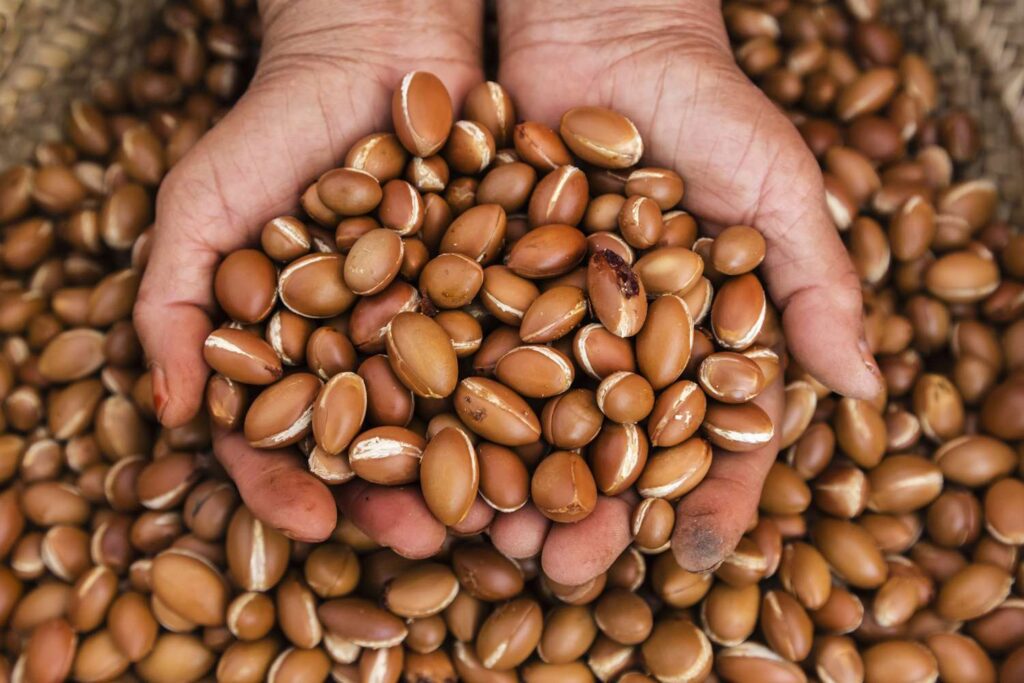Table of Contents
ToggleIntroduction
Argan oil has long been known as a traditional delicacy and beauty product in Morocco, but its cultivation and production were previously largely unorganized. In recent decades, the establishment of argan oil cooperatives has helped lift entire communities out of poverty while promoting more sustainable land use practices. By empowering primarily women producers and formalizing argan tree management, these cooperatives have had positive social, economic and environmental effects. In this article, I will explore the background of argan oil production in Morocco, discuss how cooperatives have reformed the industry, and consider their impact on sustainable agriculture and rural development.
Historical Context of Argan Oil Production
Argan trees are endemic to the semi-arid regions of Morocco, growing mainly in the Souss-Massa and Essaouira regions in the southwest. For centuries, local Berber women have produced argan oil through manual extraction of the kernels from argan fruit. The fruit shells are cracked open, the kernels inside are dried in the sun, roasted and then crushed between stones to produce the nutrient-rich oil. This oil has long been used as a cooking ingredient, a cosmetic product, and even as animal feed and a fuel for lamps.
However, argan oil production was traditionally quite arduous and unorganized. The entire process from harvest to oil extraction was done manually and on a small scale by rural women. The main challenges faced were low yields due to lack of organization and infrastructure, limited access to markets, and threatened loss of traditional knowledge as younger generations migrated to cities for work. Additionally, uncontrolled grazing and wood harvesting threatened the survival of argan forests, which provide crucial habitat and a source of livelihood.
Formation of Argan Oil Cooperatives
In the 1990s and 2000s, several international organizations began initiatives to support argan oil producers and protect argan forests. Cooperatives were formed to organize women producers, regulate land use, and help market argan oil products internationally. Some of the earliest and largest cooperatives established included the Argan Women’s Cooperative in Tamanar, the Tighanimine Cooperative outside Essaouira, and the Souss Massa National Park Cooperative near Taroudant.
These cooperatives gave producers organization, infrastructure support, training in sustainable practices, and access to premium international markets. Women could collectively harvest, process and sell oils under a recognized brand. The cooperatives invested in equipment like mechanized crushers and driers to increase yields and efficiency versus traditional manual extraction. Strict rules were set around controlled grazing, reforestation plans, and sustainable timber/fruit collection to regenerate argan forests. Profits were then reinvested back into community development projects like schools, health clinics and infrastructure upgrades.
Social and Economic Impacts of Cooperatives
The establishment of argan oil cooperatives has had many positive social and economic impacts on rural communities in Morocco. Perhaps most significantly, it has uplifted the role and livelihoods of Berber women who have always been the traditional custodians and processors of argan. By organizing women into cooperative structures and connecting them directly to profitable export markets, their incomes and decision making power within households has dramatically increased.
For example, on average a woman participating in the Tighanimine Cooperative earns around $3,000 USD annually from argan oil sales – a substantial income in rural Morocco. This money supports not just their families but is reinvested in local schools, shops and other community development projects. Participating in cooperatives has also empowered members with skills in business management, quality control, marketing and sustainable practices. As a result, many women now hold leadership roles coordinating hundreds of other producers.
The new income streams and organization created by cooperatives has had flow on effects of reducing rural-urban migration as younger generations now see viable livelihood prospects in their home villages. This population retention in turn support’s the local economy through consumption and small business activity. Additionally, increased spending power has raised community standards of living through infrastructure, education and health improvements funded by cooperative profits. Overall, argan oil cooperatives are widely regarded as one of the most successful models of sustainable rural development and female empowerment in Morocco.
Environmental Impacts of Sustainable Management Practices
In addition to social and economic impacts, argan oil cooperatives have had demonstrable positive effects on the environment through promoting sustainable land and forest management practices. Perhaps their most important achievement has been the large-scale regeneration and protection of argan forests through regulated grazing, reforestation programs and conservation plans. Previously diminishing forests are now expanding again due to cooperative rules around controlled livestock access and prohibitions on uncontrolled woodcutting.
Sustainably managed forests not only support argan production but provide crucial ecosystem services like habitat, clean water, soil stabilisation, carbon sequestration and climate regulation. They are also increasing in biodiversity as protections allow vulnerable species to recover. Reforestation efforts have included planting millions of new argan saplings to expand cover. Furthermore, cooperatives promote organic and low-impact cultivation techniques versus industrial monocropping models. Traditional crop rotations are maintained and agrochemical use is prohibited which prevents soil/water pollution.
The collective also invests profits back into multiple environmental projects. For example, they fund protected natural reserves and support community-based forest patrols and conservation brigades. Renewable energy and efficiency upgrades in oil processing plants also help lower fossil fuel reliance. Overall, argan oil cooperatives demonstrate how sustainable stewardship of indigenous species and community-led projects can regenerate degraded environments while supporting rural livelihoods – achieving both conservation and development goals simultaneously.

Challenges and Ongoing Improvements
While argan oil cooperatives have achieved great successes, some challenges remain. Initial growing pains occurred as producers adapted to more formalized systems and quality control standards. Ensuring equitable profit distribution also took time to perfect. Environmental plans likewise needed refinement as monitoring expanded forest recovery. Additionally, threats such as occasional droughts, soil degradation in overgrazed areas or disease outbreaks require adaptive management.
Market volatility can also impact prices paid to producers so diversifying export products helps stabilize incomes. Younger community members still periodically migrate for work, showing ongoing development is needed. Cooperatives also face risks associated with any businesses operating in remote regions like infrastructure constraints or supply chain disruptions. Finally, pressures from population growth and competing land uses still threaten long term forest goals if not properly addressed.
Nevertheless, cooperatives are actively working to overcome challenges through innovation. New products like aromatic waters, soaps and cosmetics have been added alongside core oil sales. Cooperative leadership is passing to younger, better educated generations equipped to navigate modern challenges. Expanded ecotourism ventures have been developed to promote forest conservation awareness while providing alternative livelihoods. Rigorous monitoring now helps cooperatives detect issues earlier and adapt forest management. Additionally, they are advocating for supportive rural development policies from local government partners.
Overall, while ongoing improvements are still required, argan oil cooperatives in Morocco demonstrate great resilience and ability to evolve successful systems. Two decades of demonstration prove that community-led, mutually beneficial models of conservation and sustainable agriculture can drive rural development when properly supported. Their example is inspiring wider replication of similar smallholder cooperative schemes for other indigenous species and livelihoods projects across Africa and beyond.
FAQs
How do argan oil cooperatives work?
Argan oil cooperatives function by organizing groups of women producers into a collective organization and business structure. Membership is voluntary and open to all local women with access to argan trees on their lands. Cooperatives provide various support services like access to processing equipment, agricultural training, quality control standards, product certification, and bulk marketing/sales channels. Profits from oil and product sales are distributed back to member producers based on amounts contributed. Cooperatives also invest earnings into community development projects voted on democratically by members. Overall the model empowers women economically while sustainably managing argan forests through rules on grazing, reforestation, wood harvesting and more set cooperatively.
What benefits do cooperatives provide women producers?
Cooperatives have vastly improved the livelihoods and empowerment of rural Berber women in Morocco. Firstly, membership provides a stable income 2-3 times higher than previous average earnings through premium oil/product prices negotiated. This financial security lifts entire families out of poverty. Cooperatives also transfer skills in business, finances, food processing and marketing. As a result, many women have risen into cooperative leadership and management roles helping hundreds more. Producing collectively further increases negotiating power for fair prices. Additionally, steady employment reduces household workload and enables social/educational opportunities previously unavailable. Overall, cooperatives transform traditionally marginalized women into leaders of sustainable development through boosted incomes, skills, confidence and decision making influence within households and communities.
How do cooperatives protect argan forests?
Cooperatives play a critical role in regenerating and sustainably managing argan forests through strict rules, planning and collective enforcement. Key measures include regulated grazing access to prevent overgrazing/soil erosion, prohibiting uncontrolled wood harvesting, replanting millions of trees, and developing long term forestry management plans. Cooperatives also established protected natural reserves and train community forest patrol/conservation brigades to monitor for illegal activities. Reinvesting profits into eco-tourism raises awareness on forest values. Rigorous monitoring through satellite data and ground surveys enables early detection of issues to be rapidly addressed. As argan trees are foundational to livelihoods, communities now view sustainable stewardship as vital for long term prosperity versus short term individual gains like past overexploitation.
How do cooperatives promote agro-ecological practices?
Cooperatives promote organic and low-impact agricultural methods suited to climate resilience and ecosystem protection. Traditional crop rotation knowledge between argan, cereals and fodder plants native to the region is maintained to naturally replenish soils without chemicals. No synthetic fertilizers or pesticides are applied which prevents pollution of water sources. Livestock are moved in a regulated fashion during harvesting to avoid overgrazing and allow plant regeneration between cycles. Forests remaining intact play key roles as habitat, windbreaks, and providers of fuelwood/construction materials sustainably. These traditional agro-ecological techniques supported by cooperatives preserve indigenous knowledge systems adapted over centuries for semi-arid environments.
What challenges do cooperatives face?
While cooperatives have achieved much success, ongoing challenges remain. Initial growing pains transitioning to new systems created difficulties, though these lessened over time. Ensuring fully equitable profit distribution also required refinement. Monitoring revealed areas needing improved forest management against threats like drought, disease or competition for land-uses. Market price volatility impacts income stability, motivating diversification. Infrastructure gaps in remote areas pose logistical constraints for some producers. Populations increasing generates more grazing/housing pressures on forests if unaddressed. Younger generations migrating shows ongoing development is vital. Finally, cooperatives undergo normal business risks associated with operating in rural environments from factors like global economic shifts, supply chain disruptions or extreme weather events. Adaptive governance continues addressing emerging challenges.
How are cooperatives addressing challenges?
Cooperatives demonstrate impressive resilience through continually adapting innovative solutions. Newly added products like cosmetics, soaps and medicinal herbs help stabilize incomes from multiple streams. Expanded eco-tourism provides alternative livelihoods while raising conservation awareness. Leveraging technology, cooperatives monitor forests/soil remotely detecting issues earlier. Investing in youth training/employment programs discourages migration. Negotiating affordable insurance schemes counteracts market volatility impacts on incomes. Strengthening governance further decentralizes power and decision making. Drawing on university partnerships broadens technical expertise available. Advocating supportive rural policies to Moroccan government also helps scale successes and attract investment. Overall, cooperatives evolve practical, community-led responses fitting social/ecological contexts versus top-down approaches. Their participatory adaptation is key to long term sustainability.
Conclusion
In conclusion, through fostering cooperation, empowering women and promoting ecological stewardship, argan oil cooperatives demonstrate impactful community-based solutions for sustainable development worldwide. By safeguarding indigenous knowledge, regeneration degraded environments and catalyzing rural prosperity simultaneously, their integrated model sets an exemplary framework. While continual learning and improvements remain, twenty years prove resilience and ability to adapt cooperatives for changing needs. Most significantly, cooperatives restored dignity, decision making power and hope for secure futures to generations of Berber women – all while regenerating forests for lasting well-being of current and future communities. Other regions now replicate their successes, proving community-centered, multi-benefit approaches can drive both grassroots welfare and global environmental protection when backed by supportive partnerships.

